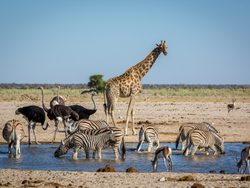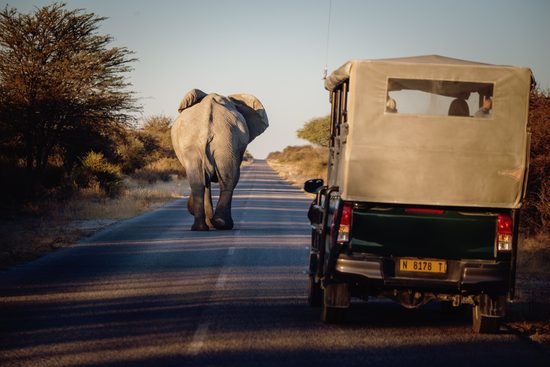
Quick Navigation
Etosha National Park is located in the Kunene region of Namibia. The name, “Etosha,” translates locally to “Great White Place.” The name of the park is derived from the Etosha pan which accounts for 23-25% of the national park area.
The pan extends 1,840 square miles (4,760 sq km) with the entire Etosha National Park accounting for 8,600 square miles (22,270 sq km). Originally a lake, the pan rarely has water unless the rains are heavy. When these rains occur, it attracts a significant number of wading birds with flamingos being one of the favorites.
The Etosha region is comprised of saline desert, savanna woodlands, savanna, and grasslands. The pans are mostly void of pants apart from some of the grasses. Moving away from the pans, Mopane trees account for approximately 80% of the forests in the national park. The majority of the park is arid and sparse with plant life making it easy to see wildlife.
The salt pans and abundance of salt splattered into the desert landscapes attracts animals who are in search of nutrients. The wildlife takes advantage of frequent visits to lick the salt concentrated places. This is one of the largest populations of large game species in all of Africa. The wildlife and unique arid landscapes create an unforgettable wilderness experience.
The national park is home to numerous species of mammals, reptiles as well as an abundance of birds. A safari through the pans and woodlands is what brings most travelers to the area. This arid region of the country makes any watering holes prime places to visit for chances of seeing wildlife. Etosha has added floodlights on several of the commonly visited watering holes to make game viewing a night easier.
Highlights
 Etosha National Park is home to the tallest elephants in Africa, however, deficiencies in nutrients have them displaying shorter tusks. Black and white rhinoceroses are spectacular sightings as well as leopard and lion. The buffalo is extinct from the area making it the only one of the Big 5 absent from the park.
Etosha National Park is home to the tallest elephants in Africa, however, deficiencies in nutrients have them displaying shorter tusks. Black and white rhinoceroses are spectacular sightings as well as leopard and lion. The buffalo is extinct from the area making it the only one of the Big 5 absent from the park.
Wildlife is the highlight of Etosha with over 110 mammal species found within the park along with an abundance and wide variety of birds to be seen by travelers. Cheetah, caracal, hyena, fox, and jackal are some of the other common predators that accompany the lions and leopards. This is considered the premier wildlife viewing destination in the whole country.
Some of the wildlife favorites that can be found within the national park include kudu, giraffe, wild dog, zebra, impala, gemsbok, hartebeest, and eland. The floodlit watering holes make for enjoyable evening game viewing. This is a unique facet of the park and a highlight for many.
Things To Do:
Visitors headed to Namibia almost always add Etosha to list of destinations to experience because of the abundant wildlife.

Game Drive
A safari game drive is the heart of the activities in the national park. This is also the best way to increase your chances of seeing more wildlife.
Etosha National Park Trails
There are no trails in the park. However, walking or hiking in the park is permissible as a guided walking safari. After receiving a safety briefing, a guide will escort you through a hike in what may be the very tracks the animals take themselves. You should be safe, but remember this is wilderness and the animals are wild. Make sure you always listen to instructions and follow them accordingly. A walking safari often leaves people with a more personal and unforgettable experience with nature.
Park Protection
Etosha National Park was created to protect the Etosha Pan and other salt pans, savanna woodlands, and grasslands that collectively serve as the habitat for an abundance of wildlife. The national park protection was essential to keep hunters and poachers from eradicating these species from existence.
Because of the investment by the Namibian government, Etosha is recognized as the premier wildlife viewing destination in the country. It is imperative that global visitors and citizens of Namibia do everything we can to help ensure that these species continue to thrive.
Etosha Highlights
- Africa’s tallest elephants
- Both black and white rhinoceroses
- Night game viewing / lighted watering holes
Park Map
Sources
- Britannica, Etosha National Park, https://www.britannica.com/place/Etosha-National-Park, retrieved June 2020.
- Etosha National Park, https://www.etoshanationalpark.org/, retrieved July 2019.
- Etosha National Park, park information site, https://etoshanationalpark.co.za/, retrieved June 2020.
- Namibian, Etosha, http://www.namibian.org/travel/namibia/etosha.htm, retrieved July 2019.
- And Beyond, The Essence of the Walking Safari, AndBeyond, retrieved June 2020.
















